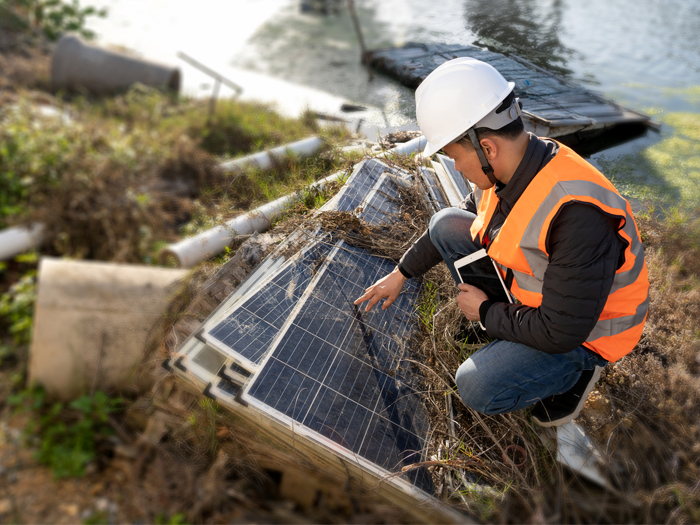kWh Analytics CEO Jason Kaminsky on the Technological Evolution of Solar Power — and Its Insurers

With the rapid growth of the renewable energy industry — driven by record-setting investment in new infrastructure projects — insurers are moving to help independent power producers cover their emerging liabilities.
But the insurance industry’s inability to gain a clear picture of the sector’s risk landscape as it expends into new technologies and geographies is leading to uneven appetite from underwriters, coverage shortfalls and a need for more specialized insurance products.
kWh Analytics, a managing general agent focused on data-driven solutions for the renewables sector, recently released its 2024 Solar Risk Assessment, offering a closer look at the solar industry’s evolving technological, operational and logistical requirements.
Risk & Insurance spoke with Jason Kaminsky, kWh’s CEO, about these and other factors shaping the solar energy industry today. What follows is a transcript, edited for length and clarity.
Risk & Insurance: Can you give me a quick overview of kWh Analytics as a company? What are your current priorities as its CEO?
Jason Kaminsky: kWh Analytics is about 12 years old, and today we operate as a managing general agent within the renewable energy space. We predominantly underwrite renewable energy property insurance, as well as some specialty forms of coverage more on the project finance side — we have a few revenue-firming products that we’ve helped structure for solar and wind to help developers raise more capital against the assets.
A little bit of the history of the company: It started out as a data risk management company. I have a background in project finance, as do a few other members of the team, so we think of insurance as an enabling form of capital that helps infrastructure capital flow into the space.
And part of the reason we got pulled into the property insurance market is that prior to 2019, insurance capacity was pretty readily available, and then we had some natural catastrophe losses as an industry and markets started pulling back.
We got a call from some of the banks suggesting that they were having a hard time making loans into the segment due to the lack of insurance. Renewable energy has a pretty unique risk profile, and insurance companies, commercial banks and infrastructure funds should be working in tandem to assess these assets.
As CEO, I’ve really focused — at least for the last year and a half — on what types of insurance products help satisfy client needs, and then try to determine how we as a data-driven MGA can help support the broader transition to a cleaner grid.
R&I: kWh Analytics recently released its 2024 Solar Risk Assessment, a report that is now in its sixth year. Who is this report for, and why is this information important?

Jason Kaminsky, CEO, kWh Analytics
JK: We’ve really targeted the Solar Risk Assessment as a data-driven report for a non-technical audience. As you can tell when you read it, it’s one-page articles with a data-driven conclusion, but it’s really written for a non-engineering audience.
When we first put it out, we were seeing results in our data that seemed relevant for the industry and felt like we should share it. At that point, it was more focused on production-related issues; assets were underperforming relative to their initial forecast, and there are all sorts of reasons why that could be, and we needed a platform to help tell that story.
And our insight at that time was that other companies are also sitting on similar insights and don’t have a forum to share it. We thought that it could be a much more powerful report by pulling in other thought leaders in the industry, who are all doing some form of technical analysis, and putting it together under a single umbrella.
It has certainly evolved over time as kWh Analytics as a company has gotten more into property insurance and the physical risks of renewables have become more of a financing issue. Some focus has shifted in that regard. This year, we added battery storage for the first time, and we had our first international contributor with Lloyd’s. But it sticks with the core of data-driven, non-marketing content for the non-technical reader.
It’s proven that it’s been read by bankers and insurance underwriters, and I’ve been told by a few academics that they use it within their courses for undergraduate and graduate students.
It’s an industry that is already big but growing rapidly — the forecast is that we’re going to install as much [new solar infrastructure] in the next five years as the past 20 years combined. So there’s going to be a lot of new people entering the industry, requiring additional tools and resources and educational touch points for people trying to learn about what’s going on and avoid the mistakes of the past. We think it’s a very important document for that purpose as well.
R&I: Were there any surprises that stood out from this year’s report?
JK: One of the biggest issues — which unfortunately takes up all the air in the room but is probably the biggest resilience issue — is hail. That was covered last year, and it’s covered this year; there are a lot of articles on hail.
And one of the shifts we’ve seen in the industry is people trying to create new technology to help mitigate that risk, which is great. In the past 18 months to two years, we’ve seen researchers actually shooting hail at different angles in a lab, resulting in a lot of innovation in this space.
There were a couple of articles on hail, including one that discussed a potential mitigation strategy — tilting the modules to an even more severe angle. A few companies have been working on more severe tilt angles, including Nextracker, who is in the report.
One of the module manufacturers had the idea to shoot hail at the frame of a panel, because as they’re tilted up in stow position, you might get hail hits on the edge of the frame, and really to explore whether there are other secondary factors that we need to be considering.
Fortunately, what they found is that solar frames are actually pretty resilient to damage, as they didn’t see any microcracking, so it’s not a huge issue. But I was impressed with the fact that when you try to fix one thing, a few other things deform, and you have to do a bit more research.
And I think that’s what makes renewable such an exciting space — you look at it and think, “How hard could it be? You’re putting rectangles in a field, and they’ve been doing it for 20 years. What could go wrong?”
But the subtleties of the complexity are often missed from afar. And once you start digging into it, you realize that there are a lot of subtleties: the glass thickness matters, the cell design matters, the frame robustness matters. These are little things that can have quite dramatic impacts when it actually comes to losses in the field.
One last thought: In the industry, up until about two years ago, the singular focus has been, how do you get electrons to be cheaper? So solar, storage and wind have been incredible deflationary asset classes. I’ve been in this industry for 17 years, and this is the first time that I’m hearing people say “Maybe we should invest in making assets more robust, more resilient, because the losses that we’re seeing out in the field are just so large.” But they currently lack the tools to make those macroeconomic decisions.
So we’re still at a point that I call the first inning of resilient asset construction — from a research perspective, from an economic analysis perspective — and giving developers the tools they need to make these decisions. But it’s the right trend; these are 30- or 40-year infrastructure assets, and the Solar Risk Assessment is one of many avenues to help push the industry forward to say, “We do want to build more robust assets that are going to withstand the useful life of that technology.”
R&I: You’ve already touched on the fact that you included BESS in the report for the first time. In terms of risk management, how are solar and BESS connected?
JK: For a long time, at least in the U.S., battery storage was only built with solar assets, so you’d build them together predominantly because you could get better pricing on your revenue contracts if you had firmer electricity delivery.
We’re also seeing technology companies and data-server companies saying “We want to procure renewables, 100% renewables, but we want to time-match when we’re procuring the electron to when our data servers are consuming the electricity.” So there’s a time match in the PPAs — the power purchase agreements.
With the Inflation Reduction Act, we’re now also allowing stand-alone storage tax credits, so you can decouple the storage asset from the renewable energy asset. That, combined with the amount of batteries that are being manufactured, is simple economics: They’re getting significantly cheaper, and as the penetration of renewables on the grid is increasing, we’re also seeing increasing need for grid resilience.
It’s similar to what we saw in solar 20 years ago, which is that costs are falling faster than people forecast, the deployments are growing more quickly than people forecast, and we’re working through early technology issues.
For storage, the main issue, at least from an insurance perspective, is fire and thermal runaway. If you get a hot cell, it ignites. There’s currently no way to put out a lithium fire; you just have to let it burn. So it’s all about how to avoid the propagation of the fire.
One of the battery companies in the report also put out some of the reliability research — how do you develop the algorithms to track how charged the battery is?
You can see the parallels to solar two decades ago, which is that it’s an incredibly deflationary technology, incredibly important from a grid resiliency perspective, and managing the flow of electrons on the grid. And there are specific applications for time-matching PPAs or for other end-user benefits that they really want to pursue.
So it’s just that storage did not see a significant deployment of capital until recently, and its growth is forecasted to be much cheaper than solar.
R&I: I’ve heard from a few brokers now that there’s a lot of appetite for renewable energy from insurers, but at the same time, it’s harder to put together a complete tower due to sub-limits, exclusions and deductibles. What might be leading to some of those difficult-to-cover gaps? Why the hesitancy to offer more unrestricted coverage?
JK: It’s the great irony that people want exposure but don’t necessarily understand the underlying risks, so they try to sell what they’re comfortable with. In renewable energy — like much infrastructure, although maybe more so because it’s a specialty large capital-intensive space — you have insurance requirements driven by large commercial banks.
And more so than in personal lines, you have a bank that’s negotiating, “Do I want to do this deal or not?” and “Here are the terms I require.” Up until 2019, the banks got very used to full limits with low deductibles, because they’re financing an asset, so if the asset gets destroyed, they lose their investment. It doesn’t matter how big of a corporate owner is standing behind it — it’s project finance, so you’re investing in an asset.
And at the same time, they’re basically asking for full [total insurable value] insurance, so people come to market with billions of dollars of TIV, and the question then becomes “What are the terms around that? What are the deductibles around that? What are the NAT Cat supplements required? And what other kinds of subtleties of solar, like micro-cracks for hail, are or are not covered?”
And as similar as banking is to insurance (it’s all structured finance and risk allocation), they speak very different languages. We came from banking into insurance. It probably took two or three years just to figure out what the heck was going on. It’s been very similar, but everyone’s speaking a very different language, and they don’t really understand how the other thinks, which is one of the roles that we play within the industry.
So what happens? You have some hail losses. The banks say, “These hail losses are much higher than any of the models are forecasting, so go get more insurance.” And the insurance companies are saying “We’ve had some hail losses; we’ve heard what the models are saying, and we don’t want to cover it anymore.” And those are obviously at odds with one another.
A broker’s piecing together $50 million of hail limit in some cases, so if an insurance company comes to market and says “We want to go to renewables but we only want to do $750,000 of hail limit,” the broker doesn’t care.
So you have this very interesting intersection of large capital-intensive infrastructure that is exposed in a way that the market generally doesn’t have great data around. And I would argue it’s mostly uncorrelated with other forms of property risk — because we’re talking more rural locations, cheaper land, and there’s not a ton of other infrastructure there — but it’s still exposed to fire, hurricane, hail, the things people care about.
That’s the underlying tension: Everyone’s seeing the same risks, and pricing and coverage adjust for that. Insurance companies and reinsurers have much less direct control over the operating decisions of their buyers, so the tool that they’ve used — which you could argue has been effective or not — has been to keep a large deductible and align incentives through that mechanism. If you’re holding a lot of risk retention, you’re going to do a better job operating it.
I don’t know if developers will necessarily internalize that until they start to see those losses roll through the book, but that’s at least been the spirit of what has been proposed. I don’t know if there’s a solution to that.
Again, as the solar industry gets better at picking locations and building more resilient assets, and [we have] more common modeling results that everyone can look at, some of those bridges will be linked.
We have our own property model with custom modifiers that we think is much more precise and accurate. But much of the industry still uses models that are not designed for renewables and give a property insurance result that could be three times too low, as the first article in the Solar Risk Assessment points out. And then people say, “Well, the model said I was going to have a $1 million loss, and the asset I invested in had a $25 million loss, so we don’t trust the models anymore.” That’s the tension that leads to that divide.
R&I: Are there any emerging insurance products that are specifically designed to address these pain points in the renewables space?
JK: There’s quite a robust industry around insuring the tax credits available for renewable energy assets, which fits within the reps and warrants underwriter market, and we’re seeing a number of carriers in that space.
For more emerging technologies, we are seeing some forms of warranty insurance. For example, NYSERDA, the New York energy authority, picked six battery storage technologies that are a little bit different than the traditional tech, and has said it plans to use these as case studies, because all these forms of technology will be needed to be deployed on the grid.
One of them is a mobile battery that can go to where there’s a crisis and help support backup power. There aren’t really products for that today, [so it’s an example of future] niche applications.
In terms of what’s difficult to insure, I hate to be a broken record on hail, but one of the ways that you mitigate hail is you tilt the panels out of the way of the hailstorm. There’s two pieces to that: one is, do you have the technology, the hardware to do that? Most of the technology is in the hardware.
And then the harder thing is — and it is surprising that it’s the harder one — how do you operationalize that? Who’s looking at whether or not the hail event is coming? Who’s pushing the button? Who’s making sure that the panels are getting out of the way? Who’s taking the risk of that?
And there are valid arguments to say different people should take that risk. Some would say the insurance company should take that risk. I would argue the owner should take that risk. You could argue the O&M, the person who’s doing operations and maintenance, should take that risk.
There’s no one, really, that feels comfortable today taking that risk, so it lands on a mix of the developer, the asset owner and the insurance company. Everyone’s pointing at each other to try to say, “Who should take the risk?” And you can’t really insure [the act of] someone pushing the button. It’s a difficult thing to insure, but very important from a from a loss profile perspective.
R&I: Do you have any advice for independent power producers and utilities looking to mitigate the risks, maybe make themselves more insurable?
JK: There’s a tension between the useful life of these assets being about 40 years, the bank loans and the tax investors being seven to 10 years, and insurance being one year.
Feedback we often hear, both from owners and their brokers, is “If I make this change, will I get credit for it from the insurance companies?” And today, most of the insurance market says no. And the developers conclude, “Well then, why am I going to invest in this?”
My biggest advice would be take the long-term view. Insurance — as much as it’s what we do, and as much as I love it — is not the quickest form of capital to adapt. It’s reasonably conservative, and I think the market will eventually match the actual underlying risk view; I think it’s pretty good at adapting to data.
And while you might not get benefits today, if you’re really reducing the risk to the asset with better vegetation management, with better modules, with better operationalizing or whatever it is — it’s a worthwhile investment to make. Because two years, three years, five or seven years from now, the insurance and companies are going to wake up and say “We need to underwrite to that.” And you don’t want to be caught holding the bag.
That would be my biggest advice: Take the long-term view even though there might not be price signals today. Again, kWh Analytics is the exception, but we don’t drive the market for every asset, especially large assets that need quota share participation. So take the long-term view, because you’re going to have to buy insurance for 40 years, and if you’re able to mitigate the risk now, it will pay dividends in the future.
R&I: Is there anything else that you think our readers should know about this topic?
JK: When we look at renewables as a segment, it’s an incredible opportunity. It’s just shy of $1 billion in the U.S. today; globally, it’s billions in premium, and it’s growing 20 to 30% a year as far as we can forecast, and solar has always outgrown the forecast that’s been put in front of it.
So the needs are massive, the opportunity is massive, and the risks are specialized. I think most insurance companies have learned it’s not quite as simple as putting up a line and nothing ever breaks. But it’s an incredible opportunity, and it’s going be a growing part of insurance companies’ books.
And what I always like to say is, kWh Analytics would love to be a part of that story, but even if we’re not, you should have a renewable energy strategy — either now or around the corner. Because it’s going to be popping up in property, liability, tax, warranty. Whatever it is, you’re going to see more energy transition risks on your books. &








